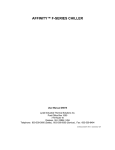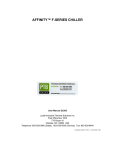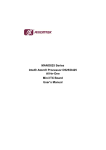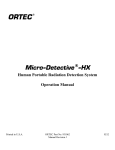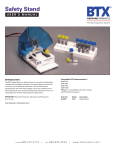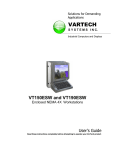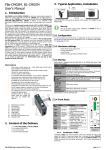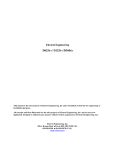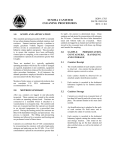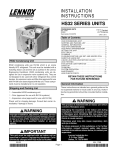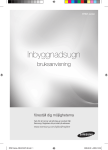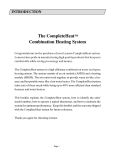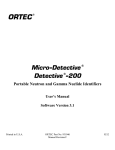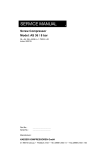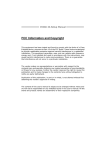Download AFFINITY™ CUSTOM CHILLER
Transcript
AFFINITY™ CUSTOM CHILLER User Manual D6621 Lydall Industrial Thermal Solutions Inc. Post Office Box 1000 775 Route 16 Ossipee NH 03864 USA Telephone: 603-539-3600 (Sales), 603-539-5005 (Service), Fax: 603-539-8484 O:\MANUALS\D6622 REV. B (02/03/2003) NMT Table of Contents Introduction Equipment Precautions Safety Precautions Installation Transporting Placement Electrical Requirements Priming the Pumps and Connecting the Coolant Loop Pressure Gauges Filters Cooling a Water-Cooled Condenser Operation Using the Controllers Programming Values for the Loop 1 Controller Programming Values for the Loop 2 Controller Changing the Set-Value Temperature Safety Alarms (Temperature) Communications Other Lights and Switches on the Control Panel General Preventive Maintenance 25-Pin Interlock Description PLC Tables Table of Contents Trouble Shooting Guide Warranty Refrigeration Diagram Coolant Flow Diagram Electrical Schematic O:\MANUALS\D6623 (11/13/2002) Introduction Congratulations on your purchase of an Affinity™ product. I want to personally welcome you to the Lydall larger family. In October of 2001, Lydall purchased Affinity Industries, in an effort to expand capability as a Total Thermal Solutions Provider. Affinity’s chillers and heat exchangers complement Lydall’s existing wide array of Passive Thermal Solutions, augmenting Lydall’s engineered thermal solutions for use in appliance, cryogenic, building products, and automotive markets. Our group is market driven as a formidable thermal solution manufacturer. Lydall, Inc. is a New York Stock Exchange listed company (NYSE: LDL) headquartered in Manchester, CT. Our company, with ten operations in the United States, France, one in Germany, and Sales/Service Offices in Japan and Singapore, is recognized for working with customers to satisfy their unique thermal solution needs, and for delivering high quality, innovative products, and exceptional service. Affinity™ products are high-precision specialty temperature-controlled equipment. The following product manual is designed to help you realize the full value of your purchase. We highly recommend that you read this manual in its entirety. The manual will assist your company with the installation, operation, and routine maintenance of your Affinity™ product. Please keep this manual readily accessible to operation and service personnel to ensure you get the most out of our product. If you have any questions about this model, or have other thermal solution needs, do not hesitate to call our Sales department (603-539-3600) or the 24/7 Service department (603-5395005). Thank you for your confidence in our ability to meet and/or exceed your needs and expectations. Sincerely, John Tattersall Group Vice President Lydall Industrial Thermal Solutions, Inc. O:\MANUALS\D3774 (01/11/2002) Equipment Precautions Failure to adhere to these precautions will void the warranty and may damage the chiller. 1. This chiller has been shipped without coolant. Do not run it without connecting the coolant lines and keeping them filled with appropriate coolant. Never run the pump dry because it will be quickly damaged without liquid. 2. Never use coolants which are incompatible with the components in this chiller’s coolant loop. Some coolants may not damage the coolant loop components, yet may significantly derate the chiller’s cooling capacity. Never use automotive antifreeze or other antifreeze containing silicates because silicates will cause the pump seals to fail. Check with the factory if there are questions about the coolant. 3. Maximum storage temperature for the unit is 52EC (125EF). 4. This chiller operates on three phase electricity. Some components are sensitive to phase sequence. The chiller is designed and wired so that all components will operate properly if the phase sequence is correct. This unit is protected by a Phase Reverse Relay, to prevent it from running if the sequence is incorrect. If the chiller fails to start on installation, a qualified electrical technician should check the relay in the electrical box. If the light on the relay is not brightly lit, the phase sequence is incorrect. The technician should switch any two wires external to the chiller. Do not modify the wiring inside the electrical box. 5. The chiller is designed for indoor use only. Do not operate the chiller in ambient temperatures below 7EC (45EF). If the chiller has been exposed to ambient temperatures below 7EC, allow 24 hours at ambient temperatures above 7EC to warm the oil in the compressor as well as the refrigerant before operating. 6. This chiller exhausts the heat it extracts to Facility Water. The Facility Water should have a temperature of 30EC (86EF) or lower. The Facility Water flow will be controlled by the water valve at the chiller’s condenser. At maximum, the flow may need to be as high as four liters (one gallon) per minute for each kilowatt of heat extracted. The Facility Water pressure should be at between two and seven bar (thirty and one hundred pounds per square inch). 7. Routinely inspect the pump inlet strainer located in the reservoir for debris. Turn the chiller off, then remove and clean the strainer as required to permit free flow of coolant. Prevent foreign debris from entering the coolant lines while the strainer is removed. Hint: A plastic sandwich bag may be used to wrap the strainer to contain most of the debris. Failure to keep the strainer clean will reduce the coolant flow and damage the pump. Equipment Precautions 8. Regularly clean the screen in the assembly at the chiller’s inlet for Facility Water. To clean, shut off the chiller, close off the supply of Facility Water to the chiller, and remove the screen. Clean as necessary and reinstall. See Installation for further instructions. 9. The compressor in this unit has been charged with a Polyolester lubricant. Polyolester lubricants (POE) will quickly absorb moisture from the ambient surroundings. Since moisture levels greater than 100 ppm will result in system corrosion and ultimate failure, it is imperative that compressors, components, containers and the entire system be kept sealed as much as possible. Lubricants will be packaged in specially designed, sealed containers. After opening, all the lubricant in a container should be used at once since it will readily absorb moisture if left exposed to ambient air. Work on systems and compressors must be carried out with the open time as short as possible. Leaving the system or compressor open during breaks or overnight MUST BE AVOIDED! Mobil EAL ARCTIC 22 CC is the preferred Polyolester due to unique additives included in this lubricant. ICI Emkarate RL 32S is an acceptable substitute if Mobil is not available. 10. As received, the POE lubricant will be clear or straw colored. After use, it may acquire a darker color. This merely reflects the activity of the lubricant’s protective additive. 11. Oil level must not fall below ¼ sight glass 12. Do not operate the chiller at coolant temperatures above or below it was specified to deliver. 13. Do not run the chiller with cooling loads that exceed its factory rated cooling capacity. 14. Do not operate damaged or leaking equipment. 15. The chiller must not be transported unless properly protected. Original factory packaging in good condition or equivalent is required. Request air-ride trucks if transporting over the road. 16. Modifying the chiller without express written consent from Lydall will void the warranty. O:\MANUALS\D6624 (10/23/2002) Safety Precautions 1. Heed all warning labels. Do not remove. 2. Do not operate the chiller with the bonnet removed. The bonnet protects personnel from rotating parts and hot surfaces and also protects the chiller’s components. 3. Connect the chiller to a properly fused disconnect box in compliance with the NEC (National Electric Code) as well as state and local codes for American usage, or local and national codes for European usage. Maximum fuses must not exceed the maximum rating found on the serial tag on the electrical box. The voltage, phase, and frequency of the power source must also match the requirements specified on the serial tag. To reduce the risk of electric shock: Do not remove cover of the remote control box (if included). Refer servicing to properly qualified and licensed personnel. Disconnect electrical power before opening the electrical box, except for the checking of the phase reverse relay or phase monitor if included with this unit (phase reverse relays or phase monitors will never be included in single phase units). Power must be applied in order for the phase reverse relay or phase monitor to indicate phase sequence. Do not operate equipment with damaged electric power cords. Turn off the chiller and disconnect electric power before servicing or moving. 4. Coolant lines, filters, and other components which connect to the chiller must be capable of withstanding the maximum pressure that the pump in the chiller can deliver at the maximum expected temperature. 5. The coolant loop has not been designed for potable water applications. Do not use the chiller for potable water. Never hook the water lines of a water-cooled unit to a potable water source or immerse a hose connected to a potable water source in the reservoir without providing back flow protection. A loss of pressure in the water source could lead to a back flow of the fluid in the unit, resulting in a possible contamination of the potable water source. 6. Vapors of some alcohol based antifreezes as well as other coolants may cause explosion if exposed to flame or spark. 7. Certain antifreezes may be poisonous if ingested. O:\MANUALS\D3799 (10/03/2002) Installation Transporting An Affinity™ chiller rolls easily on four swivel casters. The brakes must be off on the two locking casters when moving the unit. Roll the chiller gently to its operating location. The cushioned casters will help to dampen shock. Lock the casters and lower the leveling feet to support the units full weight when the unit is in place. If a forklift will be used to carry the chiller, proceed slowly and carefully to avoid jarring the unit. Insert the forks carefully to prevent damage to the casters. If the unit will be lifted by crane, use lifting strops and do not cinch the strops If the chiller will be shipped, protect it from shock and vibration or the warranty will be void. The chiller must not be transported unless suitably protected. Original factory packaging in good condition or equivalent is required. Request air-ride trucks when transporting over land. Thoroughly drain the coolant lines and blow them dry with low pressure compressed air before shipping or storing. Placement Select a level location near the application, free from dripping or spraying moisture and excessive dust. Keep the coolant lines short to allow the pump to provide maximum pressure and flow to the application. If the chiller will be placed more than 25 feet from the application, call Lydall to discuss placement and how it might affect performance. Electrical Requirements Connect the chiller to a properly fused disconnect box in compliance with the NEC (National Electric Code) as well as state and local codes for American usage, or national and local codes for European usage. Maximum fuse sizes in the disconnect box must not exceed the maximum ratings specified on the serial tag of the chiller (found on the electrical box near where the power cord connects). The voltage, phase, and frequency of the power source must also match the requirements specified on the serial tag. Note: Affinity™ models that can operate at either 208-230 volts 60 Hertz or 200-220 volts 50 Hertz have been set at the factory for 200-220 volt operation. If the operating voltage will be greater than 220 volts, a qualified electrician should remove the red wire from the contactor and replace it with the orange wire taken from the dummy fuse block. Attach the red wire to the dummy fuse block as shown in the diagram below. See the unit’s serial tag for the correct voltage range. Warning: To reduce the risk of electric shock, do NOT remove cover from the electrical box. It contains exposed high voltage wires. Refer servicing to qualified personnel. Disconnect power to the chiller before performing any service. Installation Priming the Pumps and Connecting the Coolant Loop DO NOT RUN THE PUMPS DRY. If the pumps do not establish prime, the pump shaft seals may overheat and be damaged in less than a minute. Use the following instructions when filling and assembling the coolant lines to prevent damage to the pump shaft seals. Hint: Before turning the chiller on, have sufficient clean water or coolant at hand. It will be needed immediately to make up the supply necessary to fill the coolant loop. The pumps in this unit will usually self-prime. Follow the instructions below for each loop. 1. Close the reservoir drain. 2. Fully open the flow control valve (if included). 3. Have extra coolant to add as the pump primes and the coolant loop fills. 4. Fill the reservoir with coolant. Do not fill above the height of the coolant loop connection fittings or fluid may leak out. 5. Connect the coolant lines from the application to the FPT (female pipe thread) fittings near the top of the chiller as follows. Do not over tighten the insert and do not use a sealant that will lock the male threads to the female threads. a. Connect the coolant line coming back from the application to the RETURN fitting. b. Connect the coolant line going to the application to the SUPPLY fitting. Installation 6. This chiller is equipped with a Phase Reverse Relay. The chiller will not start if the phase sequence is incorrect. If the chiller fails to start upon installation, have a qualified electrical technician check the Phase Reverse Relay in the electrical box of the chiller. If the LED is not brightly lit, the phase sequence is incorrect. The technician should switch any two of the wires at the incoming power source. Do not change any of the wiring in the electrical box. Check again for proper phase sequence before proceeding with these instructions. 7. When the previous steps are complete, turn the chiller on by placing the ON/OFF/SET switch in the ON position. Immediately check for flow. If within five seconds no turbulence is visible in the reservoir or the supply pressure gauge shows no pressure reading, shut the chiller off by placing the ON/OFF/SET switch in the OFF position. If flow is established, continue filling until the reservoir level rises to within a few inches of the top. Do not allow the reservoir to overflow. 8. If the pump does not establish prime, disconnect the SUPPLY coolant line to vent any trapped air, reconnect the line, and repeat step 7. 9. If the pump still does not prime, use the following steps: a. Disconnect both coolant lines (have a container handy to catch any overflow from the RETURN fitting). b. Force coolant into the SUPPLY fitting. The fluid will force the air out of the lines in the chiller and out of the pump head, causing it to escape into the reservoir. If tap water will be the source of coolant, simply connect the tap water line to the SUPPLY fitting and turn on the tap. If a source of coolant other than tap water will be used, elevate the coolant a few feet above the chiller, connect to the SUPPLY fitting, and let gravity force the air out into the reservoir. Remember to have a container handy to catch any overflow from the RETURN fitting. c. Reconnect the coolant lines and repeat step 7. Stop filling when the reservoir is full to within a few inches of the top. Do not allow the reservoir to overflow. A stainless steel mesh strainer attaches to the pump suction port near the bottom of the reservoir. It can easily be removed for cleaning. First turn the pump off, then pull off the strainer, rinse it clean, and push it back on. To protect the pump, routinely inspect the strainer to be sure it is clean and properly attached. Hint: If the strainer is coated with debris, wrap it with a plastic sandwich bag before pulling it off to keep most of the debris from escaping into the reservoir. Pressure Gauges Two gauges on the unit provide information on the Facility Water Pressure condition. One is labeled Facility Water In Pre-Strainer, one labeled Facility Water In Post-Strainer. Lydall suggests that the customer takes a sample reading from these gauges soon after installation. When the gauge pressure rises well above this sample reading it is time to check and clean the strainer as instructed in the Maintenance section of this manual. Installation Date Facility Water In Pre-Strainer Facility Water In Post-Strainer Filters The Deionizing Filter Is a full flow filter. (All flow leaving the unit will cycle through the filter.) All valves are in the vertical position when operating under normal conditions (not changing or bypassing any filters). To change the deionizing filter, open the bypass (H) top valve and then close the two bottom valves. After changing the filter, reverse operation. (Open lower valves, then close top valve.) The other two (micron) filters have normal in-line isolation valves for changing filters. All handles are in horizontal position when bypassing the filter. Cooling a Water-Cooled Condenser Never hook a water-cooled unit to a potable water supply without providing back flow protection. A drop in pressure in the water supply could cause back flow, resulting in the possible contamination of the potable water supply. Water-cooled chillers require Facility Water to cool the condenser during operation. The amount of flow is controlled automatically by a valve Affinity installs on the condenser. This unit requires facility water flow of 10 gallons per minute. Facility water temperature should be between 14 and 26 degrees C. Facility water pressure must be between 35 and 75 psig. Loop 2 will give the best performance (be more stable) when both loops are in operation. Connect the Facility Water supply to the "WATER IN" fitting at the bottom of the chiller. Connect the Facility Water return to the "WATER OUT" fitting. Use connecting lines of the size shown on the coolant diagram (inside diameter) to reduce pressure loss. Note: The coolant lines of all water-cooled chillers have been blown dry with low pressure air before shipping to protect the units from freezing and subsequent damage. This may cause the condenser to be dry which, in turn, could result in failure to start upon initial start-up (there could be no water in the condenser to absorb the heat). This is easily corrected by pressing the high pressure reset switch a few times to initiate flow through the Facility Water side of the chiller. O:\MANUALS\D6625 (10/03/2002) Operation Using the Controllers This chiller comes with two FUJI ELECTRIC 1/16 DIN PYX temperature controllers, one for each loop. These controllers are programmable microprocessors, which offers many more features than will need to be mastered at this point. Two additional controllers are also provided to display the flow for each loop in gallons per minute. These controllers come pre-programmed according to the Affinity™ model selected. If some of the controllers’ additional features become necessary, call Lydall service (603-539-5005) for technical assistance or consult the FUJI ELECTRIC Instruction Manual. To power the controllers without powering the chiller, place the ON/OFF/SET switch in the SET position. The digital display will light up. The number next to PV is the actual process coolant temperature. The number next to SV is the Set-Value (desired) temperature. Lights next to OUT1, OUT2, ALM1, and ALM2 may also appear. A light on next to OUT1 (when the switch is in the ON position) indicates that the chiller is cooling. Both ALM1 and ALM2 are alarms that are configured differently for different chillers. Factory Programming Values for the Loop 1 Controller Press and hold the SEL key to access the parameter menu. Use the arrow keys to change values. Display will return to PV/SV after about one minute if parameters are not being changed. Set the following values: LoCt 3 oUT1 ? Mod AT AUTo oFF All parameters user changeable Cannot be set - anything but 0.0 indicates control output #1 is energized Mode - Auto or Manual Normal control - not auto-tuned Operation P 8.0 i d Ar Man AL1T AL2T AL21 A21h AL22 A22h Loop PvT 32 0.0 17 (EC), 30 (EF) 0.0 0000 0021 30 (EC), 85 (EF) 1 (EC or F) 4 (EC), 40 (EF) 1 (EC or F) 0.00 0410 (EC) 0411 (EF) TF 4.0 SFT 0 Sv-h 41 (EC), 105 (EF) Sv-L 3 (EC), 38 (EF) CTrL Pid dT 0.5 rEv1 norM Mv-h 100.0 Mv-L 0.0 bUrn 1 STno 1 Proportional band - experimental value for HGMV - record actual values Integral time - experimental value for HGMV - record actual values Derivative time Anti-reset windup - limits integral range to control overshoot Manual resetting value (eliminates offset from P-only control) Alarm 1 type (none) Alarm 2 type (high & low absolute) Alarm 2 setpoint 1 (high absolute) Alarm 2 setpoint 1 hysteresis Alarm 2 setpoint 2 (low absolute) Alarm 2 setpoint 2 hysteresis Loop break detection time (alarms on abnormal input) 100 Ohm RTD, -50 to 100EC, 0.1 degree resolution 100 Ohm RTD, -58 to 212EF, 0.1 degree resolution Input Filter time in seconds Process Variable shift Setpoint Variable high limit Setpoint Variable low limit Control type Not supported - always 0.5 Control output #1 action - reverse for modulating HGV Manipulated variable (control output) high limit in percent Manipulated variable (control output) low limit in percent Output value when input is abnormal (set to -3% when bUrn = 1) Station number for RS 485 communications Go through the parameters twice, then set LoCt to 2, some parameters user changeable. Factory Programming Values for the Loop 2 Controller Press and hold the SEL key to access the parameter menu. Use the arrow buttons to change values. Display will return to PV/SV after about one minute if parameters are not being changed. Set the following values: LoCt 3 oUT1 ? Mod AT P AUTo oFF 6.5 i d 61 0.0 All parameters user changeable Cannot be set - anything but 0.0 indicates control output #1 is energized Mode - Auto or Manual Normal control - not auto-tuned Proportional band - experimental value for HGMV - record actual values Integral time - experimental value for HGMV - record actual values Derivative time Operation Ar Man AL1T AL2T AL21 A21h AL22 A22h Loop PvT 17 (EC), 30 (EF) 0.0 0000 0021 30 (EC), 85 (EF) 1 (EC or F) 4 (EC), 40 (EF) 1 (EC or F) 0.00 0410 (EC) 0411 (EF) TF 4.0 SFT 0 Sv-h 41 (EC), 105 (EF) Sv-L 3 (EC), 38 (EF) CTrL Pid dT 0.5 rEv1 norM Mv-h 100.0 Mv-L 0.0 bUrn 1 STno 2 Anti-reset windup - limits integral range to control overshoot Manual resetting value (eliminates offset from P-only control) Alarm 1 type (none) Alarm 2 type (high & low absolute) Alarm 2 setpoint 1 (high absolute) Alarm 2 setpoint 1 hysteresis Alarm 2 setpoint 2 (low absolute) Alarm 2 setpoint 2 hysteresis Loop break detection time (alarms on abnormal input) 100 Ohm RTD, -50 to 100EC, 0.1 degree resolution 100 Ohm RTD, -58 to 212EF, 0.1 degree resolution Input Filter time in seconds Process Variable shift Setpoint Variable high limit Setpoint Variable low limit Control type Not supported - always 0.5 Control output #1 action - reverse for modulating HGV Manipulated variable (control output) high limit in percent Manipulated variable (control output) low limit in percent Output value when input is abnormal (set to -3% when bUrn = 1) Station number for RS 485 communications Go through the parameters twice, then set LoCt to 2, some parameters user changeable. Changing the Set-Value Temperature Change the Set-Value by pressing the (>) key on the controller keypad. SV will change to a leading zero display. Continue pressing the (>) key until the appropriate digit flashes. Press the (v) or (w) key on the controller keypad until the digit changes to the desired value. Toggle through using the (>), (v), and (w) keys to change the appropriate digits until the Set-Value reads as desired. Continue pressing the (>) key until the last digit flashes. Press the (>) key one more time and all leading zeroes will extinguish. This locks in the Set-Value temperature. Caution: Never program in a Set-Value temperature of more than 32EC (90EF) unless this Affinity™ model is specifically modified to operate at higher coolant temperatures. Never program in a Set-Value temperature of less than 5EC (40EF) unless a suitable antifreeze is used as coolant AND the unit is designed to operate at below freezing temperatures. Operation Safety Alarms (Temperature) These controllers have ALM1 and ALM2 lights. ALM2 may or may not operate depending on the exact model of the PYX controller. The alarm(s) have been preset at the factory to come on when the temperature of the circulating coolant is above or below the temperature the chiller has been set to deliver. The OUT1 light on the controller (when lit) indicates that the refrigerant solenoid valve is open to allow refrigerant to flow to the heat exchanger. If the light is on most of the time, most of the chiller’s capacity is being used. If the light is on infrequently, much less than the chiller’s full capacity is being used. Communications Pins 2 and 5 on the 9-pin connector provide RS485 Communications from the controllers. Other Lights and Switches on the Control Panel HIGH PRESSURE WARNING/ALARM: Amber Lights when a high pressure condition exists in the compressor. A flashing light indicates a warning and a solid light indicates an alarm. COMPRESSOR LOW SUCTION: Amber Flashing. Activated when the compressor suction pressure is below setpoint. The chiller will shut down after a time delay. LOW REFRIGERANT LEVEL: Amber Solid when a low refrigerant level is sensed in the receiver. COMPRESSOR OVERLOAD: Amber Flashing. Activated after a 2 second delay by the current sensor in one of the leads to the compressor motor when the motor has been shut down due to excessive temperature. PHASE LOSS/REVERSAL: Amber Solid. Activated when phases of unit need to be reversed. May happen on initial start up of unit. If it occurs, switch phases exterior to unit and power unit again. LOOP 1 LOW LEVEL: Amber Solid when a low level condition is sensed by the flow switch in the Loop 1 reservoir. Operation LOOP 2 LOW LEVEL: Amber Solid when a low level condition is sensed by the flow switch in the Loop 2 reservoir. LOOP 1 PUMP OVERLOAD: Red Solid. Activated when pump amperage exceeds overload setting. Unit shuts down. The overload switch will have to be reset to the “start” position before beginning operation. LOOP 2 PUMP OVERLOAD: Red Solid. Activated when pump amperage exceeds overload setting. Unit shuts down. The overload switch will have to be reset to the “start” position before beginning operation. LOOP 1 LOW FLOW: Red Solid. Activated by the flow switch when the pump flow falls below setpoint. LOOP 2 LOW FLOW: Red Solid. Activated by the flow switch when the pump flow falls below setpoint. ALARM RESET SWITCH: Black Use to cancel an reset any alarm when the alarm condition has been corrected. General This unit requires facility water flow of 10 GPM with facility water temperature between 14-26EC, and pressure between 35 and 75 psig. The best performance (best stability of Loop 2) is achieved when both loops are in operation. O:\MANUALS\D6626 (02/03/2003) 25-Pin Interlock Description Ground AR2 Loop 2 Low Flow CR2 Loop 1 Isolation Valve CR1 Loop 2 Isolation Valve Loop 1 Temperature Alarm Loop 2 Temperature Alarm AR3 Loop 1 Low Level AR1 Loop 1 Low Flow AR5 Refrigerant High Pressure LOCAL/REMOTE AR4 Loop 2 Low Level O:\MANUALS\D6627 (11/12/2002) Pin 1 is ground Pins 3 and 4 are closed, pins 2 and 3 are open when the unit is operating normally. Pins 3 and 4 are open, pins 2 and 3 are closed when an alarm condition exists. Pins 5 and 20 operate a control relay to CR1. With this coil energized via a customer supplied 24 Volts DC signal, the Loop 1 isolation valve opens, allowing flow out of the unit. Pins 6 and 20 operate a control relay CR2. With this coil energized via a customer supplied 24 Volts DC signal, the Loop 2 isolation valve opens, allowing flow out of the unit. Pins 7 and 8 are open when the temperature is within the setpoint range and closed when the temperature is < or > than the setpoint range. Pins 9 and 10 are open when the temperature is within the setpoint range and closed when the temperature is < or > than the setpoint range. Pins 12 and 13 are closed, pins 11 and 12 are open when the unit is operating normally. Pins 12 and 13 are open, pins 11 and 12 are closed when an alarm condition exists. Pins 15 and 16 are closed, pins 15 and 14 are open when the chiller is operating normally. Pins 15 and 16 are open, pins 15 and 16 are closed when an alarm condition exists. Pins 18 and 19 are closed and pins 17 and 18 are open when unit is running normally. Pins 18 and 19 are open and pins 17 and 18 are closed when an alarm condition exists Pins 21 and 22 control the Local/Remote Option Pins 24 and 25 are closed, pins 23 and 24 are open when the unit is operating normally. Pins 24 and 25 are open, pins 23 and 24 are closed when an alarm condition exists. PLC Input Table Input Type Description Status OFF Status ON 0 Auxiliary Contact Pump 1 Overload Overload No Overload 1 Auxiliary Contact Pump 2 Overload Overload No Overload 2 Level Switch Refrigerant Low Level Level > Setpoint Level < Setpoint 3 Spare N/A N/A N/A 4 Pressure Switch Low Suction Pressure Pressure < Setpoint Pressure > Setpoint 5 Pressure Switch High Discharge Pressure Pressure > Setpoint Pressure < Setpoint 6 Flow Switch Process Flow Loop 1 Flow < Set-point Flow > Set-point 7 Level Switch Loop 1 Low Level Level > Setpoint Level < Setpoint 8 Level Switch Loop 2 Low Level Level > Setpoint Level < Setpoint 9 Pressure Switch High Pressure Warning Pressure < Setpoint Pressure > Setpoint 10 Selector Switch Pump 2 ON/OFF Pump 2 OFF Pump 2 ON 11 Selector Switch Pump 1 ON/OFF Pump 1 OFF Pump 1 ON 12 Flow Switch Process Flow Loop 2 Flow < Setpoint Flow > Setpoint Spare N/A N/A N/A 15 Auxiliary Contact Compressor Overload Overload No Overload 16 Relay Phase Reverse Relay Phase Loss/Reversal Normal 17 Switch Local/Remote Switch Local Remote 18 Reset Switch Alarm Reset Normal Resets Faults 19 Spare N/A N/A N/A 13 -14 O:\MANUALS\D6629 (10/03/2002) PLC Output Table Output Type Description Status OFF Status ON 0 Spare N/A N/A N/A 1 Interlock Refrigeration High Pressure Interlock No Alarm Alarm Condition 2 Lamp/Interlock Loop 2 Low Level Light Level > Setpoint Level < Setpoint 3 Lamp Loop 1 Low Flow Light Flow > Setpoint Flow < Setpoint 4 Lamp Loop 2 Low Level Light Flow > Setpoint Flow < Setpoint 5 Contactor Loop 2 Pump Contactor Pump OFF Pump ON 6 Lamp/Interlock Loop 1 Low Level Light Level > Setpoint Level < Setpoint 7 Lamp Combined Alarm No Alarm Flashing - Compressor Overload Solid - Phase Loss/Reversal 8 Lamp Combined Refrigeration Alarm No Alarm Flash = Low Suction Pressure Solid = Low Refrigerant Level Alarm 9 Lamp High Discharge Pressure No Alarm Flashing = Warning Solid = Shutdown 10 Contactor Loop 1 Pump Contactor Off On 11 Contactor Compressor Contactor Off On O:\MANUALS\D6630 (10/03/2002) Trouble Shooting Guide Problem Unit does not start Possible Cause Possible Remedy No power to unit, breaker tripped Verify correct power is applied, close breaker after correcting fault Low voltage Check electrical service to unit Wrong phase sequence Check phase reverse relay or phase monitor. If sequence is incorrect, switch any 2 wires on the incoming power source Refrigeration high pressure cut-out tripped Manually reset button on pressure switch after correcting fault Loose wire Disconnect power, then check wiring Defective contactor or coil Repair or replace contactor or coil Loss of refrigerant Locate and repair leak, then recharge with type and amount of refrigerant specified on serial tag Compressor damaged Replace compressor - Call Lydall Unit does not cool Compressor internal thermostat tripped Allow time for compressor to cool and automatically reset Compressor damaged Replace compressor - Call Lydall Evaporator damaged Call Lydall Microprocessor failure Replace microprocessor Facility Water control valve set too low Reset Facility Water control valve Call Lydall Microprocessor programmed incorrectly Reprogram microprocessor - Call Lydall Insufficient flow of Facility Water Increase flow of Facility Water Problem Unit does not cool (continued) Pump leaks Excessive noise on StartUp Possible Cause Possible Remedy Facility Water too warm Provide cooler Facility Water Cooling load exceeds capacity of unit Reduce cooling load Refrigeration solenoid coil failure Replace solenoid coil Loss of refrigerant Locate and repair leak, then recharge with type and amount of refrigerant specified on serial tag Solid State Relay failure Replace Solid State Relay Solenoid valve stuck shut Repair or replace solenoid valve Defective refrigeration low pressure cut-out Repair or replace low pressure cutout Malfunctioning thermal expansion valve Replace thermal expansion valve Pump damaged, loss of flow Replace pump Hot gas bypass valve setting too high Call Lydall Hot gas bypass valve stuck open Repair or replace valve Faulty pump casing Replace pump assembly Shaft seal damaged Replace shaft seal Pump housing O-Ring damaged Remove pump and rebuild Improper fluid Call Lydall Low voltage Check electrical service to unit Wrong voltage taps used on transformer Connect to proper taps Contactor or coil failure Replace contactor or coil Problem Pump motor overheats Noisy compressor Level light remains on Fault light remains on Level light does not work Possible Cause Possible Remedy Pump overload protection set too high Reset pump thermal overload relay, or replace if faulty Improper voltage supplied Correct voltage Flooding of refrigerant into crankcase Warm crankcase if unit has been off for a long period or has been left in a cool ambient for more than a few hours Worn compressor Replace compressor - Call Lydall Refrigeration high pressure cut-out set too high Adjust setting Refrigeration low pressure cut-out set too low Adjust setting Low coolant level Check for leaks, then fill reservoir Reservoir level switch float stuck Clean reservoir and level switch Time delay relay malfunction (when used) Replace time delay relay Level switch failure Replace level switch Low coolant flow See Problem; Low coolant flow No coolant flow See Problem; No coolant flow Flow switch sticking Disassemble flow switch, clean and reinstall, or replace Time delay relay has not timed out (when used) Wait for time delay relay to time out Lamp burned out Replace lamp Level switch failure Replace level switch Problem Low coolant flow No coolant flow Possible Cause Possible Remedy Pump suction strainer clogged Remove strainer, clean and reinstall or replace Flow control valve not fully open Open flow control valve Pressure relief valve set too low (unless not adjustable) Adjust pressure relief valve to specification Low coolant level in reservoir Fill reservoir to proper level Restriction in coolant lines external to chiller Eliminate restrictions in coolant lines external to chiller Frozen evaporator Call Lydall Flow switch clogged Disassemble flow switch, clean and reinstall, or replace Pump not primed Prime pump Pump suction strainer clogged Remove and clean strainer, then reinstall No coolant in reservoir Repair any leaks, then fill reservoir Pump overload tripped Wait 5 minutes for overload to reset Pump motor shaft bound to seal Replace pump or renew seal Pump housing improperly torqued Remove pump, torque to specifications, test, and reinstall Damaged pump Replace pump Frozen evaporator Call Lydall Clogged line or closed valve in external piping Check external piping for dirt or closed valve Leak(s) in external piping Repair leaks as needed Problem Possible Cause Possible Remedy Microprocessor programmed incorrectly Reprogram microprocessor - Call Lydall Malfunctioning solenoid valve Repair or replace solenoid valve Solid State Relay failure Replace Solid State Relay Microprocessor failure Replace microprocessor Refrigeration high pressure cut-out set too low Adjust and reset refrigeration high pressure cut-out Refrigeration low pressure cut-out set too high Adjust and reset refrigeration low pressure cut-out Water modulating valve set too high Adjust water modulating valve Excess refrigerant charge Remove excess refrigerant, then charge with type and amount of refrigerated listed on serial tag Pump overload setting too low Adjust and reset pump thermal overload relay to specifications, or replace if faulty Pump overload tripped Determine cause, if pump is damaged, repair or replace Low voltage Check electrical service to chiller Too much recirculating pressure to process Flow control valve set too high Throttle flow control valve Pressure relief valve set too high (unless not adjustable) Adjust pressure relief valve Compressor does not run Compressor internal thermostat tripped Allow time for compressor to cool and automatically reset Defective Solid State Motor Overload Replace module Motor burned out Replace - Call Lydall Chiller cools well below the desired SetPoint Chiller shuts down during operation Problem Compressor turns on and off automatically Temperature display reads incorrectly Microprocessor does not work O:MANUALS\D4207 (05/17/2002) Possible Cause Possible Remedy Discharge pressure too high Check Facility Water for blockage Condenser fan(s) not on Check motor(s) and wiring Refrigeration high pressure cut-out set to automatic Check settings Loose wire Disconnect power to unit, then check wiring Broken RTD Replace RTD Microprocessor failure Replace microprocessor 5 second delay has not timed out Wait at least 5 seconds after turning on Microprocessor programmed incorrectly Reprogram microprocessor - Call Lydall Microprocessor failure Replace microprocessor Warranty The Lydall Limited Warranty Twelve-Month Warranty Parts and Labor Lydall Industrial Thermal Solutions Inc. warrants this product to the original Owner for a period of twelve (12) months from the date of shipment. Lydall will repair, or, at its discretion, replace any part found to contain a manufacturing defect in material or workmanship, without charge to the Owner, for twelve months from date of shipment. Shipping costs are excluded from warranty. Service labor will be at no charge during the warranty period as long as the labor is supplied at the Lydall plant in Ossipee, New Hampshire, or by a Lydall approved service provider. Replacement or repaired parts will be warranted only for the un-expired portion of the original Warranty. To obtain prompt warranty service, contact Lydall, PO Box 1000, Ossipee, New Hampshire, 03864, USA. Before returning any equipment to Lydall for repair, it is necessary to contact the Lydall Service Department for a Return Material Authorization number and an authorized service depot location where the repairs will be completed. This Warranty does not cover the following: Damage or failure of any part caused by accident, customer shipping, storage, misuse, customer modification, fire, flood, Acts of God, or resulting from failure to properly install, operate, or maintain the product in accordance with the printed instructions provided in the User Manual. As noted in the User Manual, any modification of the unit without expressed written consent from Lydall will void the warranty. In no event shall Lydall be liable for any repairs or service or any consequence of any repair or service that are not performed in strict accordance with all applicable city, county, state, and federal laws. Further limitations and exclusions: This Warranty is in lieu of any other warranties, expressed or implied, including merchantability or fitness for a particular purpose. In no event shall Lydall be liable for any consequential or incidental damages that the Owner may incur resulting from purchase or use of this Lydall product. The buyer's sole and exclusive remedy and the liability limit of Lydall, for any loss whatever, shall not exceed the purchase price paid by the purchaser for the Lydall product on which a claim is made. Lydall Industrial Thermal Solutions Inc. Post Office Box 1000 775 Route 16 Ossipee, NH 03864 USA Telephone: 603-539-3600 (Sales), 603-539-5005 (Service), Fax: 603-539-8484 O:\MANUALS\D3777 (05/06/2002)


























